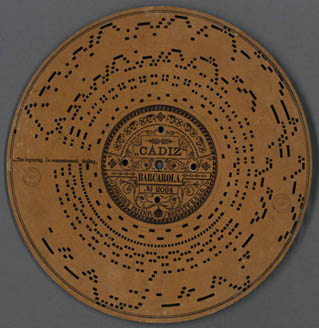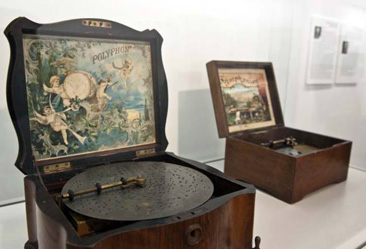Music, for a time, was made of cardboard, paper or metal. I mean, it jumped from the instruments played in live to a physical medium, in which it was stored and could enjoy again. In 1712 Jacquard discovered perforated cardboard, which was used on looms, and over a century after, the technique was applied to the mechanical music.

Disc driller cardboard with music from Cádiz

Organs for drilled at an exhibition in the Zorrilla Theatre discs Valladolid, Northern Spain
More or less known instruments are the pianos, music boxes and phonographs or gramophones too, among others. One of these supports mechanical music, whose records may have more than one home are perforated cardboard disks called Ariston, which was played on a barrel organ free tabs also called Ariston. The organ in action can be seen in some videos on Internet. Note: please click on videos.
The National Library of Spain (NLS) has incorporated, into its digital background, the image and sound 58 seconds over 70 perforated discs of the late nineteenth and early twentieth centuries. They have done the collaboration, with non-profit, the company Tecnilógica.
When asked about how they carried out the project is to recover obsolete musical formats is a technological challenge that has offered the ability to retrieve and share musical historical gems, that could well be gathering dust in an attic.
Some of the jewelry that you can listen on the website of NLS (BNE = Biblioteca Nacional de España) are: the “Ave Maria”, by Franz Schubert; the seguidillas “La verbena de la Paloma”, by Tomas Breton and even a jot from Aragon, by Isidoro Hernández, dating from between 1847 and 1888. Note: to listen them and others, please click down here:
http://bdh.bne.es/bnesearch/PlayList.do?field=todos&fechaFhasta=&text=perforado&fechaFdesde=&sort=&showYearItems=&exact=on&textH=&advanced=false&completeText=&tipomaterial1=Registro+sonoro+musical&pageNumber=1&pageSize=1&language=es
The director of digital signage Tecnilógica, Juan Antonio Casado, explained to RTVE.es that, in a visit to the NLS, the team took pictures of the drilled discs. In general, these discs consist of a circular or longitudinal cardboard holder with holes, which really is a transcript of the notes of the score. When placed in an instrument, that is powered by bellows, turning the crank musical notes are played.
When the photographs were made, they came to be that the 'instructions' for the instrument you play, could digitize it and get extract sound without touching the physical format, what on the other hand, it preserves the bracket.
First came the images to black and white, they “stretched” and prepared them in order that, when introducting them into the computer, a program distinguish where there is a note and where not and finally they generated a MIDI file. Then it blew a sample of an organ, like the keyboard of a synthesizer. In a couple of weeks, they showed the prototype to the NLS, who from that time, they spent more scans of their background.
The major difficulty of the various drilled discs is that there are many models: "Each manufacturer had theirs, and sometimes engineers went to another company, changed the format a bit and drew a different disc".
Thus, Tecnilógica members have invested the most time in research and development. They have “tuned” the algorithm, that they created for automating part of the process and had "some tolerance to notes", that are decoded from the images. In their blog, they further explain all this technical process.
Recover obsolete musical formats is, for Casado, a research and development project. "No one had done anything Scanning drilled discs", stated, and stressed that doing this kind of music archeology coupled with technology is an opportunity to retrieve information that was considered lost and that happens to be available to researchers and the curious.
"We see the work of cataloging and documentation of the National Library as if by magic, united to the magic that we make, they do arise interesting ideas" , he underlined.
Among the possible projects that could be undertaken is to create a mobile phone application for anyone to scan a disc, if it has, and upload it to a database, as archive. They would also like to have funding to carry out the digitization of 10,000 rolls of music paper for pianola, that the NLS has. They are also participating in a European project called “Impact”, to digitize funds and library catalogs.
Well, I love music, but I did not kown that drilled discs existed long before I was a child. It has been a pleasant surprise, because I like the sound of that music. I hope that you do like it too.
Till soon, kind regards,
Luis.
Sponsored by Costaluz Lawyers.
Please click down here:
